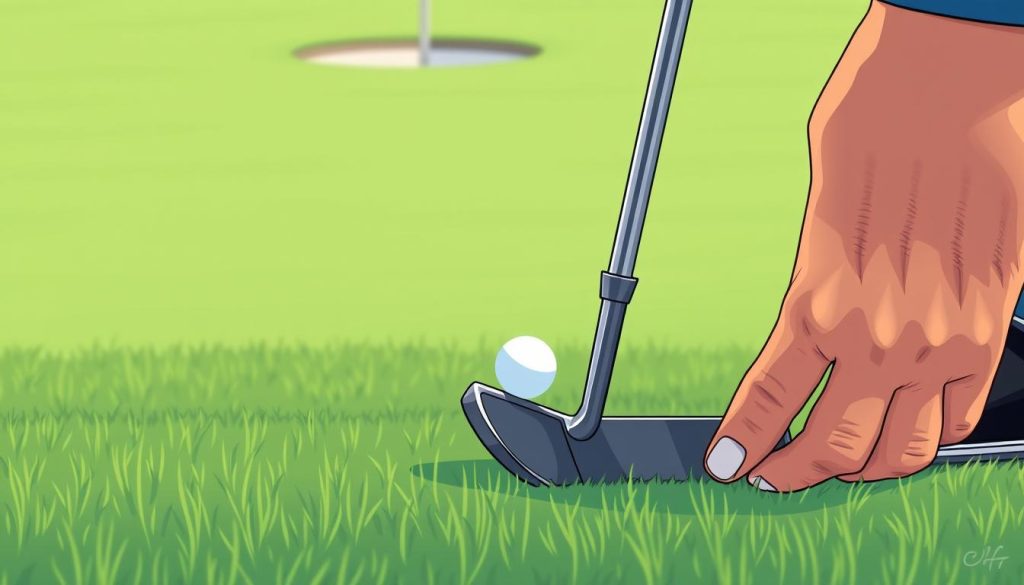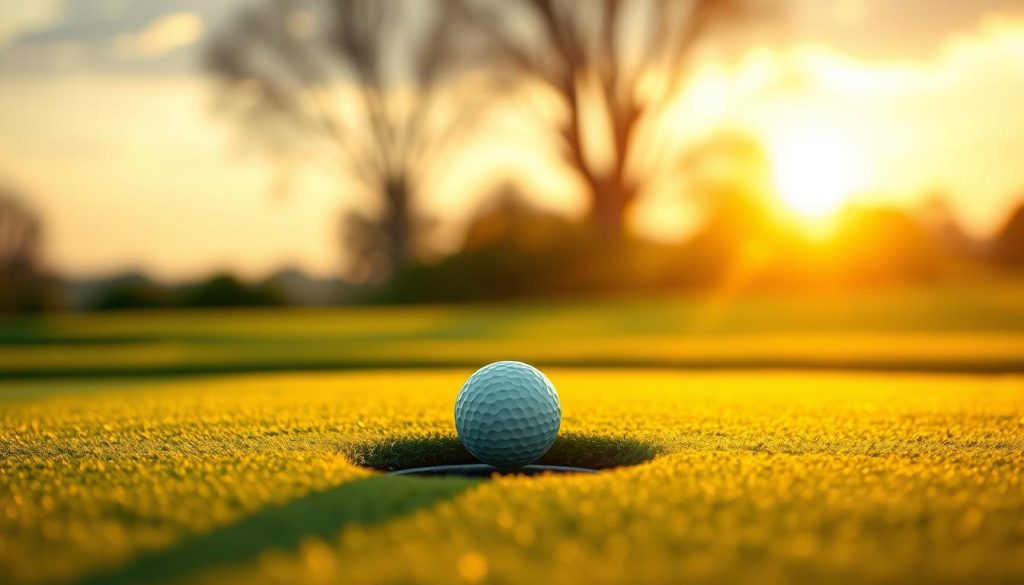Golf putting is all about precision and patience. This guide will teach you the basics and advanced techniques. You’ll learn how to improve your golf skills and master your putting.
The key to a great putt is speed, aim, and stroke. Understanding these and improving your green-reading skills will boost your putting. This guide covers everything from the basics to advanced techniques to help you get better on the green.
Key Takeaways
- Mastering golf putting requires precision, patience, and practice
- The perfect putt combines speed, aim, and stroke
- Green reading is crucial for successful putting
- Proper equipment selection impacts putting performance
- Consistent practice and training aids can improve your putting skills
Understanding the Fundamentals of Golf Putting
Golf putting is a key skill that can greatly impact your game. It’s about mastering the basics to lower your scores and feel more confident. Getting good at putting can make a big difference.
What Makes a Perfect Putt
A perfect putt needs aim, speed, and a consistent stroke. Reading the green is crucial. Pros use various methods, like feeling the slope or using the AimPoint Express system, to judge the break.
Your stance, grip, and alignment also matter a lot. They all help in executing a great putt.
The Role of Speed and Distance Control
Controlling the speed of your putt is essential. Even PGA Tour players only make half their putts from 8 feet. For casual players, aiming for within 10 feet is a good target.
Tools like Blast Motion and TIBA Putt can help you get better at speed control. Practicing on different slopes helps you feel the distance better.
Essential Components of Putting Success
Putting success depends on several key elements. A good setup means having the right body posture and eye position over the ball. Your putter face must be aligned with your target line.
Your grip, like the Reverse Overlap, affects your stroke consistency. Regular practice with drills and tools like mirrors or string lines can improve your skills.
| Component | Importance | Practice Method |
|---|---|---|
| Green Reading | Critical for aim | AimPoint Express, feet sensing |
| Speed Control | Determines accuracy | Blast Motion, TIBA Putt |
| Stroke Consistency | Ensures repeatability | Mirror drills, string lines |
Mastering Your Putting Stroke Technique
Perfecting your putting stroke is key to lowering your golf scores. The secret lies in consistency, not just quality. Let’s explore the essential elements of a solid putting technique.
Wrist movement is crucial for putter face control. Some movement is natural, but too much can lead to inaccuracy. Keep your wrists stable to improve consistency.
Stroke tempo is also vital. Aim for a 2:1 ratio between your backswing and downswing. This rhythm helps with smoother strokes and better distance control. Make this tempo a habit by practicing it often.
Grip consistency is the foundation of a reliable putting stroke. Keep the same grip pressure and hand position for every putt. This consistency leads to more predictable results on the green.
| Element | Importance | Practice Tip |
|---|---|---|
| Wrist Movement | High | Use alignment sticks to limit range |
| Stroke Tempo | Medium | Practice with metronome app |
| Putter Face Control | High | Use mirror for visual feedback |
| Grip Consistency | High | Mark grip placement on putter |
Remember, mastering these techniques takes time. Spend at least 5 minutes daily on putting practice. Focus on quality repetitions targeting specific aspects of your stroke. With patience and persistence, you’ll see significant improvements in your putting performance.
Proper Setup and Alignment for Consistent Putting
Mastering your putting stance and alignment is key to success on the green. A square stance with feet, legs, arms, and shoulders aligned to the target line is essential. This setup ensures consistency and boosts your chances of making more putts.
Body Positioning and Posture
Your putting posture is crucial for a smooth stroke. Bend at the waist so your eyes are just inside and over the ball. This position helps you move smoothly, like a pendulum.
Keep your arms in a triangle shape from setup to stroke. This improves control and precision.
Eye Position Over the Ball
Eye alignment is vital for accuracy. Place your eyes directly over or slightly inside the ball. This view helps you see the line clearly and ensures a consistent stroke.
Practice this to build muscle memory and enhance your putting.
Putter Face Alignment
Having the putter face square at address and impact is crucial for control. Use alignment aids or practice with sticks to master this. Focus on making the putter face square at impact and hit the ball in the center for better roll and distance.
| Setup Element | Key Points |
|---|---|
| Stance | Square, shoulder-width apart |
| Posture | Bend from waist, eyes over ball |
| Arm Position | Maintain triangle shape |
| Putter Face | Square to target line |
By focusing on these setup and alignment elements, you’ll improve your putting stroke. Regular practice will make these techniques second nature. See your putting skills grow on the course.
The Science Behind Green Reading
Green reading is key in golf, needing a good grasp of slope analysis and green undulations. Learning this can really boost your putting game. Let’s look at some top techniques and tools used by pros to read greens well.
The AimPoint method has changed green reading. It uses your feet to feel the slope and a hand system to show its steepness. AimPoint is super accurate, with over 99% success rate, thanks to its complex algorithms. It’s why 50% of PGA Tour winners use it to improve their putting.
The plumb bob technique is another old-school method. It involves holding the putter vertically to see the slope direction by gravity. Though not as precise as AimPoint, it’s still helpful for many golfers.
Looking at the green is also vital. By watching the undulations, you can guess how the ball will curve. Some golfers use green-reading books, but these are banned in pro tournaments now.
| Green Reading Method | Accuracy | Popularity Among Pros |
|---|---|---|
| AimPoint | 99% | 50% of PGA Tour Winners |
| Plumb Bob | 70-80% | 20% of Tour Players |
| Visual Inspection | 75-85% | 100% of Golfers |
By mixing these methods and practicing often, you can get better at reading greens. Remember, green reading is both an art and a science. It needs technical skills and intuition gained from experience.
Putting Stroke Training Guide
Mastering your putting stroke requires dedication and a solid practice plan. This guide will help you lay a strong foundation for improving your stroke and staying consistent in your training.
Building a Practice Routine
Make a balanced routine that covers different putting skills. Spend time on green reading, stroke mechanics, and controlling distance. Aim for 30 minutes of focused practice, three times a week, to see improvement.
Essential Training Drills
Include these key drills in your practice:
- Gate Drill: Improve accuracy by putting through two tees
- Distance Control Drill: Practice lag putts to various targets
- String Line Drill: Perfect your stroke path
- Ladder Drill: Enhance distance control with increasing lengths
- Clock Drill: Master short putts from different angles
Progress Tracking Methods
Keep track of your putting to see how you’re doing:
| Method | Description | Frequency |
|---|---|---|
| Scoring System | Assign points for putts made/missed from various distances | Weekly |
| Video Analysis | Record and review your stroke for consistency | Bi-weekly |
| Putting Stats | Track putts per round during play | Every round |
Consistency in your practice is crucial for stroke improvement. Stay committed to your drills and track your progress often for the best results.
Advanced Stroke Control and Feel Development
Improving your putting game starts with mastering advanced stroke control. It’s all about managing your stroke path and face control. Many think a straight-back-straight-through method is best, but the truth is, your stroke has a slight arc. This knowledge helps you avoid common mistakes like pulling or pushing your putts.
Face control is key to where your putt goes. To get consistent results, keep your face square at impact. This takes practice and knowing your stroke mechanics. Building feel also takes time and commitment to your craft.

- Set up three balls at different distances from the hole
- Focus on your stroke path for each putt
- Pay attention to the face control at impact
- Repeat the process, noting any improvements in feel
About 25% of stroke survivors face minor recovery challenges. By using these advanced techniques in your practice, you’re not just improving your game. You’re also helping your recovery.
| Aspect | Focus Area | Impact on Putting |
|---|---|---|
| Stroke Path | Arc management | Reduces pulled/pushed putts |
| Face Control | Square at impact | Improves directional accuracy |
| Feel Development | Consistent practice | Enhances overall putting performance |
By focusing on these advanced techniques, you’ll see big improvements in your putting. Just like in stroke recovery, where 10% of survivors almost fully recover, dedication to your putting stroke can lead to amazing results.
Equipment Selection and Setup
Choosing the right putter and setting up your equipment can really boost your putting game. Let’s look at the important things to think about when picking and setting up your putting gear.
Choosing the Right Putter
The type of putter you use is key to your putting stroke. Blade putters give a classic feel, while mallet putters are more forgiving. Your choice should match your putting style and what you like.
Think about the length, weight, and balance point of the putter. Finding the perfect fit is crucial.
Grip Types and Their Impact
The grip you use can change how accurate and consistent your putting is. You can choose from conventional, left hand low, or claw grips. Try out different grips to find one that feels right and helps you make a smooth stroke.
Custom Fitting Considerations
Getting a custom fit is key for optimizing your equipment. A pro fitting can help find the right putter length, loft, and lie angle for you. This tailored approach makes sure your putter fits your natural motion.
| Fitting Aspect | Importance | Impact on Performance |
|---|---|---|
| Putter Length | High | Affects posture and eye position |
| Putter Weight | Medium | Influences stroke tempo and feel |
| Grip Size | High | Affects hand position and wrist action |
| Loft and Lie | Medium | Impacts ball roll and alignment |
By focusing on these key factors, you’ll be on your way to better putting and lower scores on the green.
Mental Aspects of Putting Excellence
Mastering the mental game is key for putting excellence. Your confidence in putting can greatly affect your performance. Golf legends like Johnny Miller and Jack Nicklaus have shared their mental strategies for putting.
Building confidence in putting starts with practice. Spend time on the green, focusing on your technique. Listen to the sound of the ball hitting the putter face. This helps your mind prepare for solid contact, boosting your performance.

Managing pressure is crucial in big moments. Use visualization to picture yourself succeeding. A simple One-Two count can help keep your stroke consistent. These methods keep your focus on the task at hand.
Quiet eye training has been shown to improve putting under pressure. It involves keeping a steady gaze on the ball. This leads to better focus and less anxiety.
| Mental Aspect | Technique | Benefit |
|---|---|---|
| Confidence Building | Regular practice | Improved stroke consistency |
| Pressure Management | Visualization | Better performance in high-stakes situations |
| Focus Enhancement | Quiet eye training | Reduced anxiety and increased accuracy |
| Rhythm Maintenance | One-Two count | Consistent putting stroke |
Remember, putting excellence comes from both physical skill and mental strength. By adding these mental strategies to your practice, you’ll see better putting confidence and performance.
Indoor Practice Solutions and Training Aids
Golf needs regular practice to get better. Indoor putting greens and training aids let golfers work on their skills at home. They help with putting, like stroke mechanics and alignment.
Putting Mats and Simulators
Indoor putting greens are flat or have hills. The Perfect Practice Putting Mat shows you how to improve your stroke. Simulators give you real green conditions and show your performance right away.
Mirror Training Tools
Putting mirrors are great for better alignment and stance. They let you see your eye position over the ball. The Putting Stroke Teacher, at $29.99, works on three key things:
- Aligning shoulders with the aim line
- Maintaining shaft plane angle
- Achieving a pendulum-like swing motion
Alignment Aids
Alignment tools help you have a steady stroke path. Rods and laser guides make sure your putter face is right at impact. The PuttOUT Devil Balls give you quick feedback on face angle, making your putting more accurate.
| Training Aid | Focus Area | Key Benefit |
|---|---|---|
| Perfect Practice Putting Mat | Stroke Technique | Visual Feedback |
| Putting Stroke Teacher | Fundamentals | Shoulder Alignment, Shaft Plane, Pendulum Motion |
| PuttOUT Devil Balls | Face Angle | Instant Impact Feedback |
Using these indoor practice tools can really boost your putting. Remember, regular practice with the right tools is crucial. It helps lower your handicap and improves your golf game.
Conclusion
Mastering the putting stroke can change the game for golfers looking to improve. This guide covered key elements for better putting, from basic techniques to advanced strategies. With consistent practice, you can greatly enhance your performance on the greens.
Putting is crucial, making up nearly half of your total strokes in a round. Pros like Cameron Smith have shown the power of great putting. Smith’s records at big tournaments highlight the need for practice, proper technique, and mental focus.
To get better at putting, do short practice sessions regularly. Try drills like the Gate Drill and Distance Control Drill. Find the right putter for you and use technology like putting mats or training aids. With hard work and the right approach, you’ll see big improvements in your putting, leading to better scores and more fun on the course.
FAQ
What are the three essential components of a perfect putt?
How important is green reading in golf putting?
What is the ideal tempo ratio for a putting stroke?
How should I position my body for a proper putting setup?
What is the AimPoint method in green reading?
What are some effective putting drills for improving stroke consistency?
How does putter face control affect putting accuracy?
What are the main types of putters, and how do I choose the right one?
How can I improve my mental game for putting?
What are some useful indoor practice solutions for putting?
How can I develop better feel in my putting stroke?
What role does grip consistency play in putting?
Source Links
- https://skillest.com/blog/master-the-art-of-golf-putting-a-comprehensive-guide-for-beginners/
- https://hackmotion.com/putting-stroke-tips/
- https://visioputting.com/
- https://www.scienceandmotion.com/download/docs/fundamentals/The Fundamentals of Putting1.pdf
- https://www.golfzongolf.com/blog/technology/the-art-of-putting-in-golf-a-comprehensive-guide
- https://practical-golf.com/putting-tips
- https://www.golfzonleadbetter.com/blogs/master-your-putting-game-6-effective-putting-drills-for-precision-speed-alignment/
- https://hittingitsolid.com/blogs/news/the-perfect-putting-stroke-3-keys-to-mastering-every-time
- https://swingtrainer.com/blogs/instruction/putting-stroke-technique-tips?srsltid=AfmBOopMuj8sXj5v1bkX9LteHBviRU1nW5Uum30Hpq-0dWJ6S5Ub9q-N
- https://golf.com/instruction/putting/struggle-putting-aim-intimidating-drill-jackson-koert/
- https://aimpointgolf.com/?srsltid=AfmBOoqOk1VFl9NnWQd1iz3QKqTDg9AWGwa-3T0RX2iTBAXimIfnh5k4
- https://patents.google.com/patent/US8337321B2/en
- https://www.golftrainingaids.com/collections/putting-aids?srsltid=AfmBOoowNmkkY8OmUhIZX6bE01CPxNQ2khmeo_gv3jZjJF1vY4ESAAyN
- https://pmc.ncbi.nlm.nih.gov/articles/PMC3196659/
- https://www.healthline.com/health/stroke-treatment-and-timing/brain-exercises-for-stroke-recovery
- https://golf.com/instruction/putting/putting-exercises-at-home-adam-smith/
- https://palmbirdputtergrips.com/how-to-improve-putting-consistency-and-performance/
- https://visioputting.com/improve-your-putting-learn-to-line-up-the-ball-accurately/
- https://golf.com/instruction/putting/johnny-miller-clever-putting-tip-timeless-tips/
- https://www.nature.com/articles/s41598-024-55716-z
- https://www.teamunify.com/reczzhwi/__doc__/311038_4_Wheel of Excellence.pdf
- https://www.golfmonthly.com/best-golf-deals/best-golf-training-aids-137815
- https://theputtingarc.com/product/putting-stroke-teacher/
- https://twoputtpro.com/blogs/putting-ball-and-drills/better-putting-stroke?srsltid=AfmBOooMUaQmE81KyFewSE-sl6kVn2S8N2_0xmqD7606DLCMxStrtQPt
- https://twoputtpro.com/blogs/putting-ball-and-drills/master-your-putting?srsltid=AfmBOooUwRfwqtMMoAnEdQt0OjvxH456L6Dy6-jXO4dmvyz_aIooqzAU
- https://www.golfaustralia.com.au/feature/a-stroke-of-genius-how-to-putt-like-cam-smith-586029


